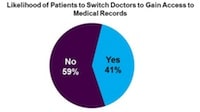4 Data-Driven Factoids for Smarter Marketing
 Here are four useful—and survey based—reports that your healthcare marketing radar might have missed. Each offers an insightful read on ways to fine-tune your plan and operation for smarter and more successful results.
Here are four useful—and survey based—reports that your healthcare marketing radar might have missed. Each offers an insightful read on ways to fine-tune your plan and operation for smarter and more successful results.
Respond to web-generated leads within five minutes. Sounds impossible? Individuals who use the CONTACT page, MORE INFORMATION request or similar inquiry pages on your website are—at that very moment—a genuinely interested prospect. They have raised their hand and said “I’m-interested-right-now.” Your likely success with this “right-now” prospect is about a thousand-fold better within the first five minutes, according to a Lead Response Management Study. Beyond the first five minutes, the contact rates cool quickly. In a busy office (which is just about everyone), sounds like a near-impossible challenge, but the greater likelihood of success is worth the investment to test.
Your Internet marketing net has some big holes in it. Most of us in marketing and communications are using computers, laptops, smartphones and tablets constantly. The Internet is pervasive, ubiquitous and virtually indispensible. Pump your marketing or advertising message out via the Internet and/or email and you’ve completely covered everyone. Not so, Pew Internet tells us in Who’s Not Online and Why. About 15 percent of American over-18 adults do not use the Internet or email. The full report breaks it down, but you’ll need other ways to reach non-users who say the Internet is not relevant, they have no need, or factors of cost and availability.
Patients would switch physicians for access to their electronic medical records online. As many as 41 percent of Americans would change physicians for EMR access, according to an Accenture Survey.

The business-growing opportunity here is that most consumers believe they should have full access to their medical records, but doctors are not as receptive to the idea. In contrast, 65 percent of physicians believe a patient's access to EMRs should be limited. About one-third of US consumers have full EMR access, reflecting the trend in patient engagement.
Text messages are more helpful than in-person provider visits, some patients say. A study by Televox looks at how digital media is helping doctors and patients, and this report says that technology aids in communication, patient engagement, higher level of care, and cost-effective healthcare delivery. Obviously in-office and in-person visits are core considerations. But between visits, patients receiving voicemail, text or email feel more valued as a patient, improved their opinion of the provider and more certain about return future visits.
DIGGING DEEPER: For more on this topic, here are 23 Useful Internet Marketing Stats.








